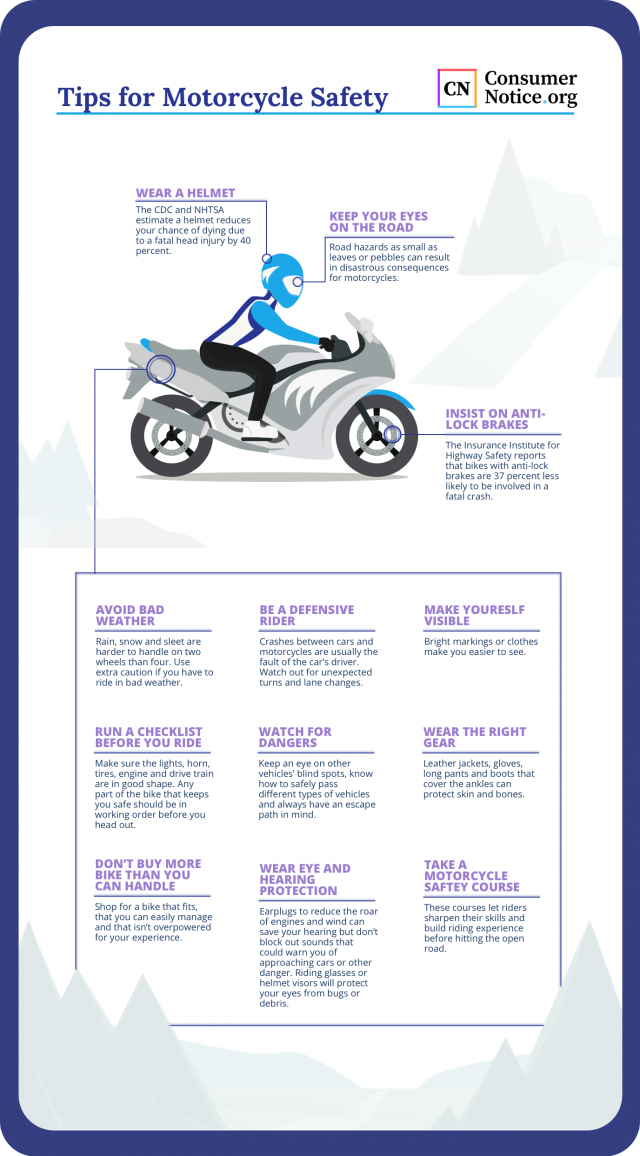Motorcycle Accidents
Motorcyclists face more risks on the road than do people in passenger vehicles. Motorcycles have fewer safety features than cars, and their riders are more exposed to other vehicles and hazards on the road. Understanding these risks can help motorcyclists avoid serious crashes.

Motorcycles made up just 3 percent of all registered vehicles in the United States in 2016 and accounted for less than 1 percent of all vehicle miles traveled in the country.
But per registered vehicles, the fatality rate for motorcyclists was six times the fatality rate for people in cars. And if you look at the fatality rate per vehicle miles traveled, motorcyclist fatalities happened nearly 28 times more often than fatalities involving people in cars.
Injuries from motorcycle crashes also happen more frequently than injuries from car crashes, and they tend to be more serious, too.
A study published in 2017 in the Canadian Medical Association Journal looked at the number of severe injuries per 100,000 motorcycles and per 100,000 cars and found that severe injuries happened 10 times more often with motorcycles than with cars.
Top Risks for Motorcyclists
Colliding with other vehicles, speeding, drinking alcohol, not wearing a helmet and getting older all contribute to fatal motorcycle crashes in the United States, according to the National Highway Traffic Safety Administration.
Contributing Factors for Motorcycle Fatalities, 2016*
| CONTRIBUTING FACTOR | MOTORCYCLE FATALITIES |
|---|---|
| Collision with another vehicle | 55% |
| 40-and-older age group | 54% |
| Failure to wear a helmet | 41% |
| Speeding | 33% |
| Alcohol | 25% |
| Crash with a fixed object | 23% |
High Cost of Motorcycle Crashes
Injuries from motorcycle crashes are almost twice as costly to treat as injuries from car crashes, according to the 2017 study in the Canadian Medical Association Journal.
Researchers looked at the costs of crashes around Ontario, Canada. They found the average medical bill for a motorcyclist injured in a crash was $4,341 ($5,825 Canadian) compared to $2,232 ($2,995 Canadian) for a person injured in a car crash.
The researchers looked only at costs over the 30 days following a crash. The study did not take into account long-term treatment, including physical therapy or other rehabilitation. So the costs could be much higher.
The study also looked solely at crashes around Ontario. Medical expenses for motor vehicle crashes in the United States may be even higher.
Helmets
Helmets, or riding without them, are a passionate issue for motorcyclists. Riders’ organizations have campaigned for years to have states relax helmet requirements.
Currently, 19 states and the District of Columbia have universal helmet laws that require all riders and passengers to wear helmets. Another 28 states require some motorcyclists to wear helmets, and three states don’t have helmet use laws at all.
Some states that repealed helmet laws saw increases in motorcycle fatalities. Texas saw a 31 percent hike in motorcycle deaths and Arkansas saw a 21 percent rise after the states dropped helmet requirements, according to Consumer Reports.
The U.S. Centers for Disease Control and Prevention surveyed data from medical researchers and the National Highway Traffic Safety Administration in 2017. It found that helmet use would have cut deaths by more than a third, saved hundreds of lives and saved $1 billion in costs related to motorcycle crashes.
CDC Motorcycle Helmet Facts
- Helmets saved 1,859 lives in 2016.
- Helmets would have saved 802 more lives had all motorcyclists worn them.
- Helmets reduce the risk of death by 37 percent.
- Helmets reduce the risk of head injury by 69 percent.
- The United States could save more than $1 billion every year with 100 percent helmet use.
For the best protection, use helmets approved by the U.S. Department of Transportation. These will have a DOT certification label on the back.
Riders should replace helmets every five years because they deteriorate over time. They should also replace their helmets after any crash.

Source: National Highway Traffic Safety Administration
Dangers from Other Vehicles
More than 40 percent of two-vehicle fatal motorcycle crashes in 2016 involved a vehicle making a left turn while a motorcycle was going straight, passing or overtaking the vehicle, according to the Insurance Institute for Highway Safety. A 2018 National Transportation Safety Board report found the second most common scenario was a motorcyclist falling onto the road to avoid a crash with another vehicle.
A 2015 study in the Journal Traffic Injury Prevention found that motorcyclists identified risks on the road that safety researchers had not even considered. These included dangers with “no engineering or scientific solutions.” The authors concluded that safety researchers should work more closely with motorcyclists to identify the best strategies for improving motorcycle safety.
Researchers with the Motorcycle Safety Foundation and Virginia Tech Transportation Institute tracked 100 riders for over 366,000 miles and found that 56 percent of serious accidents involved motorcycles being rear-ended or sideswiped by a passing vehicle.
“When motorcycles and other vehicles collide, it is usually the other (non-motorcycle) driver who violates the motorcyclist’s right-of-way,” according to the Motorcycle Safety Foundation.
When motorcycles and other vehicles collide, it is usually the other (non-motorcycle) driver who violates the motorcyclist’s right-of-way.
Airbags, collision sensors and other technology have made trucks and cars safer in recent decades. But a 2018 report from the National Transportation Safety Board found many of the systems still could not detect motorcycles when the passenger car was turning left or changing lanes. These are two of the most common types of collisions between cars and motorcycles.
The Insurance Institute for Highway Safety says crash avoidance systems that address crashes in which a car turns left in front of a motorcycle “would more than quadruple the potential benefit” of the technology for fatal crashes. But it warns that it’s still not clear how well the current technology performs.
In the meantime, motorcycle safety groups, insurers and safety regulators all recommend bright, highly visible outer gear as one of the most important safety precautions motorcyclists can take to prevent collisions with other vehicles.
Drugs and Alcohol
Alcohol and drugs, including prescription medications, can increase your chances of serious injury or death on a motorcycle. The substances can affect your judgement, balance, and ability to control steering, shifting and braking. They can also affect how you react to people, vehicles and other collision threats around you.
Alcohol plays a larger role in motorcycle crashes than in crashes involving any other type of vehicle. More than a third of riders killed in single-vehicle motorcycle crashes in 2016 were alcohol-impaired. Those killed in nighttime crashes were three times more frequently impaired than riders in daytime fatal crashes.
Alcohol-related motorcycle deaths spike on weekends. Twenty-one percent of motorcycle riders killed in weekday crashes in 2016 had a blood alcohol content of .08 or higher compared to 31 percent of riders killed in crashes over the weekend.
Speeding
Fatal single-vehicle crashes are most often due to speed and distraction, according to a 2018 report from the Governors Highway Safety Association.
The safety of lane-splitting — the practice of riding a motorcycle between lanes of slow moving or stopped traffic — is also greatly affected by speeds. California is the only state where the practice was legal as of 2019. But Washington state, Arizona and Massachusetts have all considered legalizing the practice in recent years, and campaigns are underway in at least 14 states to adopt lane-splitting laws.
The Governors Highway Safety Association reports that at least one study suggests the practice may be safe at low speeds. But the association does not take a position on the practice.
Age
Riders 50 years old and older accounted for 36 percent of motorcycle fatalities in 2016, according to the Insurance Institute for Highway Safety. The National Safety Council says this may be related to “re-entry riders,” or people who gave up riding when they were younger and returned to motorcycles later in life.
The council warns that older riders shouldn’t rely on their past experience. Instead, they should be aware that their reaction times and physical abilities have slowed with age and distracted driving by other people is a much greater problem for motorcyclists today.
Newer bikes may also be more powerful than the ones re-entry riders last rode. Data show that engine size has played an increasing role in motorcycle fatalities.
In 2016, 33 percent of motorcycle fatalities involved engines larger than 1,400 cubic centimeters, according to the Insurance Institute for Highway Safety. Engines that large accounted for 9 percent of fatalities in 2000 and just 2 percent in 1997.
A 2016 study in Injury Epidemiology looked into the increasing motorcycle mortality rate of baby boomers. Researchers concluded that mandatory training courses for re-entry riders born between 1946 and 1964 could reduce the risk of fatal crashes.
Younger riders still make up a large group of fatalities, especially when speeding and sports bikes are involved. However, 16 states reported that most motorcycle crashes in their states involve riders who are older.
“Recently, there has been a shift from younger riders being overrepresented in motorcyclist fatalities to riders over the age of 40 comprising the greatest share of motorcyclist fatalities nationwide,” according to the Governors Highway Safety Association.
Motorcycle Safety Tips
Stay safe on your motorcycle by being aware of the risks around you on the road. While most serious motorcycle crashes may be the fault of other drivers, you can still take steps to protect yourself from “the other guy.”

15 Cited Research Articles
Consumernotice.org adheres to the highest ethical standards for content production and references only credible sources of information, including government reports, interviews with experts, highly regarded nonprofit organizations, peer-reviewed journals, court records and academic organizations. You can learn more about our dedication to relevance, accuracy and transparency by reading our editorial policy.
- Canadian Medical Association Journal. (2017, November 20). Motorcycle Crashes Cause 5 Times as Many Deaths as Car Accidents, 6 Times the Health Care Costs. News Release. Retrieved from https://www.sciencedaily.com/releases/2017/11/171120085439.htm
- Consumer Reports. (2013, April). 10 Motorcycle Safety Tips for New Riders. Retrieved from https://www.consumerreports.org/cro/2013/04/10-motorcycle-safety-tips-for-new-riders/index.htm
- Governors Highway Safety Association. (2018, May). Motorcyclist Traffic Fatalities by State; 2017 Preliminary Data. GHSA. https://www.ghsa.org/sites/default/files/2018-05/ghsa_motorcyclists18.pdf
- Insurance Institute for Highway Safety. (2016). Motorcycles and ATVs. Retrieved from https://web.archive.org/web/20171221060004/https://www.iihs.org/iihs/topics/t/motorcycles/fatalityfacts/motorcycles/2016
- Insurance Institute for Highway Safety. (2019, February). Motorcycle Helmet Use. Retrieved from https://www.iihs.org/topics/motorcycles#helmet-laws
- National Highway Traffic Safety Administration. (2018, February). Traffic Safety Facts, 2016 Data; Motorcycles. Retrieved from https://crashstats.nhtsa.dot.gov/Api/Public/ViewPublication/812492
- National Safety Council. (n.d.). Motorcycle Safety is a Two-Way Street. Retrieved from https://www.nsc.org/road-safety/safety-topics/motorcycle-safety
- National Transportation Safety Board. (2018, September 11). Select Risk Factors Associated with Causes of Motorcycle Crashes. Safety Report. Retrieved from https://www.ntsb.gov/safety/safety-studies/Documents/SR1801.pdf
- Padway, M. (n.d.). The Ultimate Motorcycle Safety Guide: Tips for New Riders. Michael Padway & Associates. Retrieved from https://www.michaelpadway.com/riding-skills-and-safety/ultimate-motorcycle-safety-guide
- Pincus, D. et al. (2017, November 20). Direct Medical Costs of Motorcycle Crashes in Ontario. Canadian Medical Association Journal. Retrieved from https://www.cmaj.ca/content/189/46/E1410
- Puac-Polanco, V., Keyes, K.M. and Li, G. (2016, August 9). Mortality from Motorcycle Crashes: The Baby-Boomer Cohort Effect. Injury Epidemiology. Retrieved from https://www.ncbi.nlm.nih.gov/pmc/articles/PMC4978754/
- Simpson, J.C., Wilson, S. and Currey, N. (2014, October 9). Motorcyclists' Perceptions and Experiences of Riding and Risk and Their Advice for Safety. Traffic Injury Prevention. Retrieved from https://www.ncbi.nlm.nih.gov/pubmed/24761932
- Thielking, M. (2017, November 20). Motorcycle Crashes Are Alarmingly Common – and Incredibly Costly. STAT. Retrieved from https://www.statnews.com/2017/11/20/motorcycle-crashes-deadly/
- U.S. Internal Revenue Service. (2019, January 30). Yearly Average Currency Exchange Rates. Retrieved from https://www.irs.gov/individuals/international-taxpayers/yearly-average-currency-exchange-rates
- Williams, V. et al. (n.d.). Factors that Increase and Decrease Motorcyclist Crash Risk. Virginia Tech Transportation Institute/Motorcycle Safety Foundation. Retrieved from https://www.msf-usa.org/downloads/msf100_2016/Risk_Factors_From_MSF_100_Study_Paper.pdf
Calling this number connects you with a Consumer Notice, LLC representative. We will direct you to one of our trusted legal partners for a free case review.
Consumer Notice, LLC's trusted legal partners support the organization's mission to keep people safe from dangerous drugs and medical devices. For more information, visit our partners page.
844-420-1914
